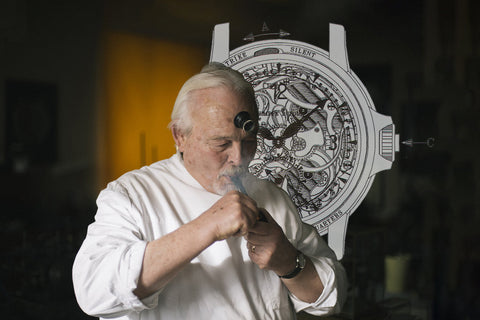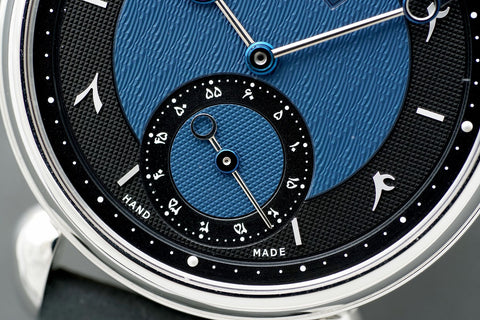Philippe Dufour followed his remarkable achievement of creating the Grande et Petite Sonnerie wristwatch by chasing another first in wristwatches. His focus was a double balance architecture aimed at minimising the effect of positional errors on amplitude. As with much of his inspiration, such a double balance architecture had a history in the Vallée de Joux, with students tackling it in their school watches at the start of the 20th century.
Dufour’s iteration of this idea is at the heart of the Duality, which he first presented in 1996, after several years of development. Like in the school watches, the principle Dufour leveraged was taking the average rates of the two balances, positioned in opposition to each other. The thinking is that such a set up would halve the effect of gravity on each individual balance. Utilising an average of the rate of both balances to power the drive train would better chronometry. Says watchmaker Bernhard Zwinz who – before setting up his independent brand Winnerl – worked with Dufour on the Simplicity, “It was known that the Duality was inspired by a school clock from Le Sentier. Dufour was not only inspired by the design of the watch, but also the architecture of the bridges. Of course, it was a great challenge to transfer this into a wristwatch.”
Dufour’s innovation involves a differential that sits between the two balances. Between the two driving wheels, orientated horizontally, are smaller gears of the differential. Each of the driving wheels interacts with one escape wheel, providing impulse to and from a balance. The mean impulse from both balances drives the seconds hand of the Duality.
Says Luca Soprana, a watchmaker who has long admired the Duality’s mechanical ingenuity, “The beauty of the idea of a double balance wheel, where the differential is on the seconds wheel, is classical and complex. Now almost no double balance watches have a differential on the seconds – they all have it on the intermediate wheel or centre wheel. It is a great challenge, because the force you get by placing the differential here is very small. The architecture is very delicate and tricky, and demands really fine adjustment to get it to work properly, but the beauty and the refinement of the mechanism is incredible.” The complexity Soprana speaks of is perhaps one of the reasons why Dufour, who had initially planned a series of 25 pieces, eventually only made 10 examples of the Duality.
Additionally, one balance runs at a marginally faster rate (than the standard 21,600 vibrations per hour). This, almost negligible difference in rates cancels each other out across a wide variety of positions, further aiding linear timekeeping. Theoretically, such an arrangement also means that if one balance is blocked, the other continues to power the drive train at roughly half the rate – the seconds hand then would take about two minutes to complete a revolution around the subsidiary register.
While by the time Zwinz arrived at Dufour’s workshop, the Simplicity series was closed, he did have the opportunity to study the drawing and designs of the watch and is intimately familiar with the movement mechanics.
He says, “The central component of the Duality was of course the differential, which distributes the energy from just one barrel to two escapements and balances. This was unique at the time and very challenging to produce due to its small dimensions. The differential is made up of 21 different parts, all in a very small space, which was also a challenge when servicing the watches. The adjustment of the two balance wheels was also time-consuming. The differential allowed each individual balance wheel to be regulated independently. I had to immerse myself very deeply in the regulating mechanism and optimise the escapement in order to make the best use of the forces of the mainspring barrel and increase the amplitude. I also had to optimise the shape of the hairspring and dynamically balance the two balances.”
Seen through the sapphire crystal caseback, the manually wound calibre is thoughtfully laid out and finely finished. The balance and escapement bridges mirror each other’s form. The large bridge that anchors the gear train is similarly reflected in the form of the bridge holding the differential in place, despite their different scales. The edges of the bridges are decorated with fine anglage, while the tips of the escapement bridges are black polished. Beautiful anglage, with delicate texture, adorns the bridges, giving it a lustrous appearance. All decoration, like so much of the watch itself, is done by hand. The makers’ mark, place of origin, jewel count (40) and serial number adorn the main bridge.
In this example, the calibre is paired with a platinum case and a silvered dial, an exceedingly understated configuration of a classical design. The three parts of the case wear equally rounded profiles and are high polished. The lugs, of equal width as the midcase, tape and curve down gently. They are 18mm apart and come furnished with a grey Saffiano leather strap secured by a white gold pin buckle. The crown is knurled and substantial.
The silver dial has a fine, sunburst texture, and is populated by a quarter of applied Arabic markers, with the remaining hours denoted by triple faceted markers. Inside it is a black chemin de fer chapter of minutes. The offset subsidiary seconds register is recessed and framed by a metal ring. It features circular engine turning, with a black printed chapter of seconds. While the hours and minutes hands are dauphine style and faceted, the one plying the seconds register is feuille-style.
The Duality is rightly regarded as one of the most consequential watches of the modern era, not just for its mechanical ingenuity but also due to the exceedingly finite numbers it was made in. While the Grande et Petite Sonnerie that came before it was a mechanical tour de force and the Simplicity that followed it an exercise in restraint, the Duality is at once from both those worlds and also from neither – it occupies a unique position in Dufour’s body of work.
If sold within the United Kingdom, this Philippe Dufour Duality will be subject to 20% VAT
























































































































































































































